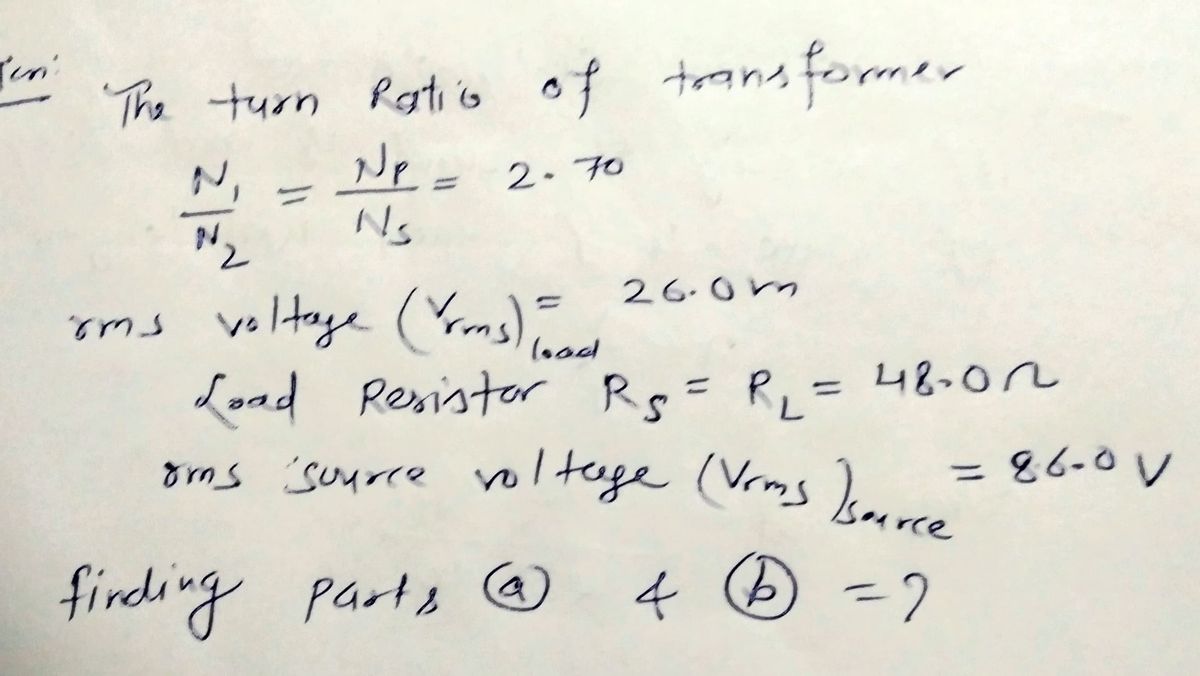The figure below shows an AC source, a transformer with a turns ratio of N₁/N₂ = 2.70, a source resistor Rs, and R₂ ΔV, eeeee N₂ R₁ load resistor R₁. Ⓡ A voltmeter across the load resistor measures an rms voltage of 26.0 V when the load resistor R₁ is 48.00 and the rms source voltage is AVS = 86.0 V. (a) Determine the value of the source resistor R, (in (2). x How is the rms voltage across the secondary coil related to that of the primary? How is the power delivered to the primary related to the power delivered to the load resistor? How are the voltages across each element on the primary side related to each other? (b) What If? If the turns ratio is increased to 3.00, determine the source resistance (in 2) required to deliver the same amount of power to the load. How can you modify your work from part (a) in order to determine the source resistance required to deliver the same amount of power to the load resistor as in part (a)? Q
The figure below shows an AC source, a transformer with a turns ratio of N₁/N₂ = 2.70, a source resistor Rs, and R₂ ΔV, eeeee N₂ R₁ load resistor R₁. Ⓡ A voltmeter across the load resistor measures an rms voltage of 26.0 V when the load resistor R₁ is 48.00 and the rms source voltage is AVS = 86.0 V. (a) Determine the value of the source resistor R, (in (2). x How is the rms voltage across the secondary coil related to that of the primary? How is the power delivered to the primary related to the power delivered to the load resistor? How are the voltages across each element on the primary side related to each other? (b) What If? If the turns ratio is increased to 3.00, determine the source resistance (in 2) required to deliver the same amount of power to the load. How can you modify your work from part (a) in order to determine the source resistance required to deliver the same amount of power to the load resistor as in part (a)? Q
College Physics
11th Edition
ISBN:9781305952300
Author:Raymond A. Serway, Chris Vuille
Publisher:Raymond A. Serway, Chris Vuille
Chapter1: Units, Trigonometry. And Vectors
Section: Chapter Questions
Problem 1CQ: Estimate the order of magnitude of the length, in meters, of each of the following; (a) a mouse, (b)...
Related questions
Question

Transcribed Image Text:The figure depicts an AC source connected to a transformer with a turns ratio of \( N_1/N_2 = 2.70 \). The circuit also includes a source resistor \( R_S \) and a load resistor \( R_L \).
### Description of Circuit Elements:
1. **AC Source (\( \Delta V_S \))**: Provides an rms voltage of 86.0 V.
2. **Transformer**:
- Primary coil (\( N_1 \))
- Secondary coil (\( N_2 \))
- Turns ratio of \( N_1/N_2 = 2.70 \)
3. **Source Resistor (\( R_S \))**: Value to be determined.
4. **Load Resistor (\( R_L \))**: Has a resistance of 48.0 \(\Omega\).
### Measurements:
- The voltmeter across the load resistor measures an rms voltage of 26.0 V.
### Tasks:
#### (a) Determine the Value of the Source Resistor \( R_S \) (in \(\Omega\)):
- Consider the relationship between rms voltages across the primary and secondary coils.
- Analyze how power is transferred from the primary to the load resistor.
**Guidance**: Reflect on the voltage relationship in each part of the circuit and the power delivery relative to each element.
#### (b) Analyze the Case When the Turns Ratio is Increased to 3.00:
- Calculate the \( R_S \) needed to deliver the same power to the load as in part (a).
**Guidance**: Adjust your approach from part (a) to account for the change in the turns ratio and its effect on source resistance and power delivery.
### General Tips:
- Understand the role of the transformer in adjusting voltage and current levels.
- Use Kirchhoff's laws and power equations to establish relationships between circuit parameters.
- Consider the efficiency and power conservation principles in transformers while solving the problems.
Expert Solution
Step 1: Determining the given data

Step by step
Solved in 4 steps with 4 images

Knowledge Booster
Learn more about
Need a deep-dive on the concept behind this application? Look no further. Learn more about this topic, physics and related others by exploring similar questions and additional content below.Similar questions
Recommended textbooks for you

College Physics
Physics
ISBN:
9781305952300
Author:
Raymond A. Serway, Chris Vuille
Publisher:
Cengage Learning

University Physics (14th Edition)
Physics
ISBN:
9780133969290
Author:
Hugh D. Young, Roger A. Freedman
Publisher:
PEARSON

Introduction To Quantum Mechanics
Physics
ISBN:
9781107189638
Author:
Griffiths, David J., Schroeter, Darrell F.
Publisher:
Cambridge University Press

College Physics
Physics
ISBN:
9781305952300
Author:
Raymond A. Serway, Chris Vuille
Publisher:
Cengage Learning

University Physics (14th Edition)
Physics
ISBN:
9780133969290
Author:
Hugh D. Young, Roger A. Freedman
Publisher:
PEARSON

Introduction To Quantum Mechanics
Physics
ISBN:
9781107189638
Author:
Griffiths, David J., Schroeter, Darrell F.
Publisher:
Cambridge University Press

Physics for Scientists and Engineers
Physics
ISBN:
9781337553278
Author:
Raymond A. Serway, John W. Jewett
Publisher:
Cengage Learning

Lecture- Tutorials for Introductory Astronomy
Physics
ISBN:
9780321820464
Author:
Edward E. Prather, Tim P. Slater, Jeff P. Adams, Gina Brissenden
Publisher:
Addison-Wesley

College Physics: A Strategic Approach (4th Editio…
Physics
ISBN:
9780134609034
Author:
Randall D. Knight (Professor Emeritus), Brian Jones, Stuart Field
Publisher:
PEARSON